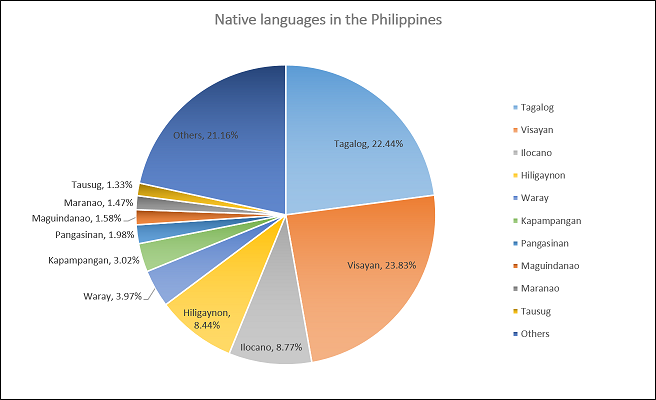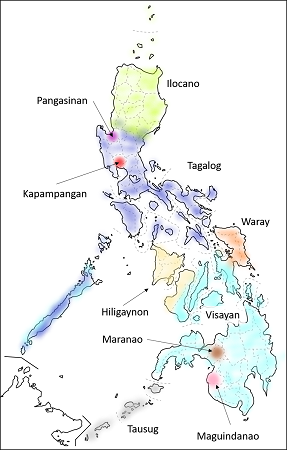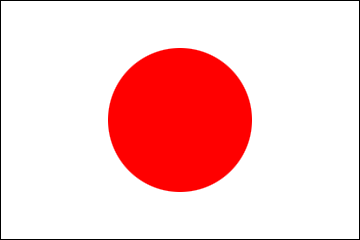Letter from Cebu (14) ”Why do Cebuanos speak mostly Visayan and English?”
2023/1/18
Letter from Cebu (14)
"Why do Cebuanos speak mostly Visayan and English?"
"Why do Cebuanos speak mostly Visayan and English?"
The official languages of the Philippines are Filipino and English. Filipino is the standardized variety of Tagalog dialect, mainly spoen by the people in Metro Manila. But, Cebuanos do not use Filipino as their main language. They speak Visayan (Cebuano) and English. Readers in Japan may think that “the difference between Tagalog and Visayan may be like that of Standard Japanese and Osaka dialect.” However, Tagalog and Visayan are very different. Most verbs of the two languages are different. Visayan has no honorific words nor a preposition equivalent to “of” in English. The position of adverb in a sentence is also different. What is common is only basic grammar (S+V+O) and borrowed words from English and Spanish. As a result, Tagalog speakers hardly understand Visayan even if they visit Cebu or Visayas.
There are more than 180 languages in the Philippines, in addition to Tagalog and Visayan. Those languages are used by the local people on a daily basis. This situation seems to be surprising to the Japanese who has only one language in the country. What has caused this language diversity in the Philippines?
There are more than 180 languages in the Philippines, in addition to Tagalog and Visayan. Those languages are used by the local people on a daily basis. This situation seems to be surprising to the Japanese who has only one language in the country. What has caused this language diversity in the Philippines?
(Proportion of Native Language Speakers in the Philippines)

The first question to cross my mind was “Why Spanish is not the official language of the Philippines? Why English?” The official languages of Latin American countries which Spain conquered and colonized are Spanish without exception. Spain colonized the Philippines for 333 years, longer than the colonization period of most Latin American countries. It should seem natural for Filipino to speak Spanish and the official language of the Philippines has to become Spanish by now. I could not understand the reason why the Spanish has not become the official language of the Philippines for a while. It seems unthinkable to me that Spaniards had put a lot of efforts for spreading Spanish in Latin America, while the same people had not done so in the Philippines.
The answer to this question, as far as I know, is that Spaniards were not eager to spread Spanish both in Latin America and the Philippines. Based on the history, Spain introduced the encomienda as their initial colonization policy of Latin America. The encomienda was a Spanish labor system that rewarded conquerors with the labor of conquered local peoples. So, Spanish colonists were interested in using the local people as the labor, and were not interested in educating them very much. On the other hand, Spanish friars who missioned Christianity in Latin America learned the local language for their effective and efficient mission. They were also not interested in teaching Spanish to the local people at the initial stage of the colonization. Later, some bishops started to criticize the encomienda as exploitative and savage.
In addition, what differentiated Latin America from the Philippines in terms of Spanish education was the interest and perception of churches and friars there. In the Philippines, churches and friars were allowed to possess land since the earlier colonization period. Churches and friars accumulated huge power and money through their land. Churches in the Philippines, by the end of the colonization period, have possessed 185,000 hectare of land, that is, one fifteenth of all arable land in the country. Since churches had this vested interest in preserving the status quo, churches regarded Spanish education as a tool for making obedient local people disobedient, and for weakening their power. Churches opposed and disrupted Spanish Government’s efforts for educating local people. For example, Spanish Government introduced a basic education law for giving Filipinos basic knowledge of industry and technology as well as Spanish. Friars obstructed the implementation of this law by threatening, punishing and even purging elementary school teachers. As a result, one research shows that even in 1876, only 2.16% of elementary school local students could speak Spanish.
This marks a stark contrast to what happened in Latin America. For example, in Mexico, in late 18th century, Francisco de Lorenzana, Archbishop of Mexico wrote a letter to Spanish King, Carlos III, and said that too many native languages in Mexico make it difficult for them to mission. In response, the King sent Spanish teachers to Mexico and started Spanish education in a full-fledged manner. Some researchers maintain that this Spanish education laid the ground for the independence of Mexico in 1821.
Eventually, in the Philippines, despite 333 years of Spanish colonization, Spanish was not spread among the local people, and more than 180 of native languages were preserved among the local people.
The United States, on the other hand, after colonizing the Philippines in 1898, introduced compulsory elementary education in 1901, and put a lot of energy and efforts for educating the local people, including English education, leading to a rapid and wide spread of English throughout the country.
My second question was “Why is Filipino based on Tagalog. Wasn’t there any other alternatives, such as creating Filipino by unifying three main local languages, Tagalog, Visayan and Ilocano, or accepting three main languages as official languages?” I found that there were discussions regarding those matters, at the national level for a long time. Prior to introducing the 1935 Philippine Constitution, opinions were divided between people for selecting only one local language (that is Tagalog) as the basis of the standard Filipino, and people for choosing several local languages as the basis of the standard Filipino, or unifying those languages into one. Eventually, the 1935 Philippine Constitution specifies that “measures will be taken toward the development and adoption of a common national language based on one of the existing native languages. (Article 14, Chapter 3)”. Prior to the formulation of the 1973 Philippine Constitution, there was an opinion that new national language should be the one which unifies several local languages. But, that opinion was not adopted for the reason that such an artificial attempt may not succeed. The 1987 Philippine Constitution provides “the national language called Filipino that unifies several languages of the Philippines”. However, in reality, Filipino is derived from Tagalog.
The answer to this question, as far as I know, is that Spaniards were not eager to spread Spanish both in Latin America and the Philippines. Based on the history, Spain introduced the encomienda as their initial colonization policy of Latin America. The encomienda was a Spanish labor system that rewarded conquerors with the labor of conquered local peoples. So, Spanish colonists were interested in using the local people as the labor, and were not interested in educating them very much. On the other hand, Spanish friars who missioned Christianity in Latin America learned the local language for their effective and efficient mission. They were also not interested in teaching Spanish to the local people at the initial stage of the colonization. Later, some bishops started to criticize the encomienda as exploitative and savage.
In addition, what differentiated Latin America from the Philippines in terms of Spanish education was the interest and perception of churches and friars there. In the Philippines, churches and friars were allowed to possess land since the earlier colonization period. Churches and friars accumulated huge power and money through their land. Churches in the Philippines, by the end of the colonization period, have possessed 185,000 hectare of land, that is, one fifteenth of all arable land in the country. Since churches had this vested interest in preserving the status quo, churches regarded Spanish education as a tool for making obedient local people disobedient, and for weakening their power. Churches opposed and disrupted Spanish Government’s efforts for educating local people. For example, Spanish Government introduced a basic education law for giving Filipinos basic knowledge of industry and technology as well as Spanish. Friars obstructed the implementation of this law by threatening, punishing and even purging elementary school teachers. As a result, one research shows that even in 1876, only 2.16% of elementary school local students could speak Spanish.
This marks a stark contrast to what happened in Latin America. For example, in Mexico, in late 18th century, Francisco de Lorenzana, Archbishop of Mexico wrote a letter to Spanish King, Carlos III, and said that too many native languages in Mexico make it difficult for them to mission. In response, the King sent Spanish teachers to Mexico and started Spanish education in a full-fledged manner. Some researchers maintain that this Spanish education laid the ground for the independence of Mexico in 1821.
Eventually, in the Philippines, despite 333 years of Spanish colonization, Spanish was not spread among the local people, and more than 180 of native languages were preserved among the local people.
The United States, on the other hand, after colonizing the Philippines in 1898, introduced compulsory elementary education in 1901, and put a lot of energy and efforts for educating the local people, including English education, leading to a rapid and wide spread of English throughout the country.
My second question was “Why is Filipino based on Tagalog. Wasn’t there any other alternatives, such as creating Filipino by unifying three main local languages, Tagalog, Visayan and Ilocano, or accepting three main languages as official languages?” I found that there were discussions regarding those matters, at the national level for a long time. Prior to introducing the 1935 Philippine Constitution, opinions were divided between people for selecting only one local language (that is Tagalog) as the basis of the standard Filipino, and people for choosing several local languages as the basis of the standard Filipino, or unifying those languages into one. Eventually, the 1935 Philippine Constitution specifies that “measures will be taken toward the development and adoption of a common national language based on one of the existing native languages. (Article 14, Chapter 3)”. Prior to the formulation of the 1973 Philippine Constitution, there was an opinion that new national language should be the one which unifies several local languages. But, that opinion was not adopted for the reason that such an artificial attempt may not succeed. The 1987 Philippine Constitution provides “the national language called Filipino that unifies several languages of the Philippines”. However, in reality, Filipino is derived from Tagalog.
(Geographical Expansion of Visayan Speakers)

I am not in a position to judge whether it was appropriate to adopt Tagalog as the basis of Filipino, the national language. But, what I am convinced after staying in Cebu for seven months is that Cebuanos will never use Filipino(Tagalog) in Cebu and Visayas. This is because I feel that Cebuanos harbor a sense of rivalry against Manila, and that Cebuanos have pride towards Cebu. Cebuanos also seem to resist a kind of Manila-centered cultural expansion in the Philippines.
Based on my observation, Cebuanos learn Filipino and English at school. But, they utilize Visayan as their everyday language and never use Tagalog. This seems to impose extra burden on Cebuanos in a sense that they have to learn three languages (English, Tagalog and Visayan), while people in Manila need to learn only two languages (Tagalog and English). However, there are data showing that Visayan speakers are good at learning foreign languages and good at English than Tagalog speakers. Visayan speakers may expand their activities as multilinguals.
Based on my observation, Cebuanos learn Filipino and English at school. But, they utilize Visayan as their everyday language and never use Tagalog. This seems to impose extra burden on Cebuanos in a sense that they have to learn three languages (English, Tagalog and Visayan), while people in Manila need to learn only two languages (Tagalog and English). However, there are data showing that Visayan speakers are good at learning foreign languages and good at English than Tagalog speakers. Visayan speakers may expand their activities as multilinguals.
Hideki YAMAJI
Consul General of Japan in Cebu
(Reference)
“Elementary school education in the Philippines under the Spanish rule –since 1863-“, Akira Nakazato, Yawata University
“Language Education of the colonial power of the Philippines”, in “Modern Asia Educational History Research”, Jiro Igarashi, Iwasaki Gakujutsu Shuppan, 1969
“Basic knowledge of Latin America”, Naotaro Shimizu, Vol.20 No.6 June 2019, Global Tenri
“Elementary school education in the Philippines under the Spanish rule –since 1863-“, Akira Nakazato, Yawata University
“Language Education of the colonial power of the Philippines”, in “Modern Asia Educational History Research”, Jiro Igarashi, Iwasaki Gakujutsu Shuppan, 1969
“Basic knowledge of Latin America”, Naotaro Shimizu, Vol.20 No.6 June 2019, Global Tenri
(end)
